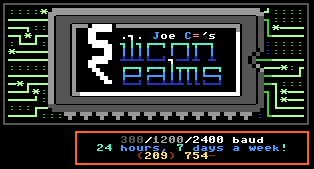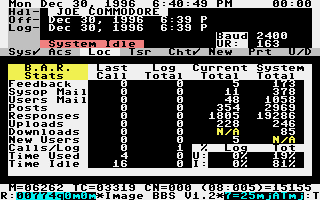Table of Contents
the SILICON REALMS BBS!
The Silcon Realms BBS, a good BBS, a Commodore BBS.
It was 1985 when I bought my first modem, it was a “Total Telecommunications” 64 Modem for the unbelievable low price of $20, back then 300 baud was still used by many. I remember calling long-distance numbers in the nearby cities and thoroughly enjoying the experience, Apple, Atari, TRS-80 and Commdore 64 BBSs all were out there. Of course these cities were long-distance calls to me, and there were no local BBSs. So I took the plunge and the 'MotherLode 64 BBS went on line in March of 1987. At that time it was running on 'All American BBS' with that 300 baud modem, it used two 1541s and an MSD dual Drive, and was on-line only during the evenings (since we only had a voice line at the time.) But even with those limitations it soon became a popular BBS, partially for being one of the first BBSs in the area, and I would hope, because it was one of the better boards in the area.
As the years progressed the BBS has had drive upgrades to 1571 and then 1581 drives, the computer switched between a 64 and 128 a few times but has stayed with the 64 most for its life. The software went from All American to C-Net 10 then 12 and then Finally Image 1.2 BBS.
About the Silicon Realms Today
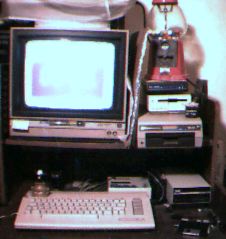 The Silicon Realms ran for 17 years (1987-2004) during the entire run, the Realms ran on a Commodore 64 (or 128 in 64 mode), and being a small BBS it catered to those who have no need for fancy terminals, or 80 column screen displays. We were more than happy to see and help the beginning modem user to get their feet wet. And of course Commodore 8-bit users are especially welcome!
The Silicon Realms ran for 17 years (1987-2004) during the entire run, the Realms ran on a Commodore 64 (or 128 in 64 mode), and being a small BBS it catered to those who have no need for fancy terminals, or 80 column screen displays. We were more than happy to see and help the beginning modem user to get their feet wet. And of course Commodore 8-bit users are especially welcome!
The 'Realms last ran Image BBS (v1.2a) which is a truly wonderful modular BBS package, it had not only allowed me to add features but also can translate Commodore graphics characters & color (which is standard for Commodore BBSs) to IBM PC graphics & ANSI color, so everyone will get a good picture! In the latter part of it's run, the 'Realms was networked to other Commodore BBSs around the world, had a hard drive for much improved capacity and access time, runs at a maximum of 14,400 baud (with the recent addition of CMDs Turbo 232 interface and software patches), and had a dedicated BBS line for 24 hour service.
Users come and users go; almost all of the original callers to the board have either moved on or moved away. For the callers we still have, the BBS still gets a wide diversity of callers; male and female from 9 years to in their 80s, from local calls to as far away as Europe, using Plus/4s to those with State-of-the-Art (snicker) IBM compatibles. In the early 2000s the callership went way down, not only to the Silicon Realms, but to all BBSs, as other diversions (mainly the Internet) lure away the users with promises of 'greener phosphers'. Silicon Realms succumbed to me being to busy and it having issues I had no time to resolve.
Remember; when you are looking for something to do on a quiet day - try calling a BBS - yes, there are several dail-ups still out there, and many, even Commodore ones) can be reached through the internet now. Besides your sysop being glad to see your handle on the caller log, you can connect with your fellow users and maybe find out what's going on recently.
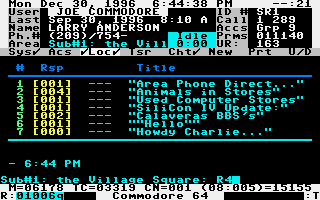 The Silicon Realms was part of many networks of Commodore BBSs. A 'BBS Network' allows BBSs to transfer E-mail and mesage-base topics between other boards; each board (called a node) automatically calls one or two other boards down the line during low-cost night hours a few times a week to share data, it may not be fast, but it is pretty effiecent. Recent deveopments in the Commodore BBS communities have made it now possible to tie together many different Commodore BBS networks (of systems that are not just Image BBS!) into a meta-network which we call CommNet (sort for Commodore Network). More then 60 Commodore BBSs in the U.S. (including a few in Canada) were linked together to share information and provide entertainment and support for each other and our callership.
The Silicon Realms was part of many networks of Commodore BBSs. A 'BBS Network' allows BBSs to transfer E-mail and mesage-base topics between other boards; each board (called a node) automatically calls one or two other boards down the line during low-cost night hours a few times a week to share data, it may not be fast, but it is pretty effiecent. Recent deveopments in the Commodore BBS communities have made it now possible to tie together many different Commodore BBS networks (of systems that are not just Image BBS!) into a meta-network which we call CommNet (sort for Commodore Network). More then 60 Commodore BBSs in the U.S. (including a few in Canada) were linked together to share information and provide entertainment and support for each other and our callership.
Current Hardware/Software that makes the Silicon Realms what it is:
- Commodore 128 computer (running in 64 mode)
- CMD HD w/160 mb storage
- CMD RamLink w/4mb RamDisk Capacity
- CMD Swiftlink & US Robotics 14.4k bps modem
- Commodore 1084 Color Monitor
- Commodore 1581 Disk Drive*
- Commodore 1541 Disk Drive*
- Image 1.2 BBS
- Image Networking/TurboRELs modification
- ECS 'Extended Command System' Menu Modification
- FutureNet CommNet network mail/subboard modifications
- Various single and multi-player game programs
* used only for archiving and disk transfers.
About Image BBS
(try Image BBS yourself, now available for download!)
See also: http://www.zimmers.net/bbs/ for information about many commdore BBSs (including Image)
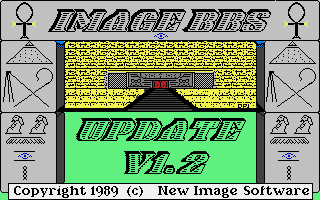 Image BBS, originally published by New Image Software is a modular BBS environment written for the Commodore 64 or 128 in 64 mode. Image BBS is written in both Machine Language and BASIC, with the core functions (such as error handling, modem connection, text handling, file transfer protocols, and C/G/ASCII/ANSI translation) written in Machine Language, the Magagement/Support system (command structure, prompts, disk handling, etc.) written in a BASIC, and the the individual modules (message bases section, E-Mail, U/D directory handler, on-line games, etc) also as BASIC sub-modules. The ML gives Image the speed necessary and the BASIC gives the sysops ultimate control on the 'look and feel' of their BBSs without having to pay exorbitant licensing fees. Image BBS is closely related to C-Net DS-2 and C-NET 128 BBS as these were all based on the C-Net 12.0 BBS and earlier. The standard Image BBS Software Package handles modem speeds up to 2400 baud (faster with a free update from New Image and use of CMD's Swiftlink/Turbo RS-232 interface.) and is written to support the popular line of Commodore Disk Drives, RAM Expansions, CMD hard drives and Xetec hard drives. Though not written for the new CMD SuperCPU Accelerator, it does function reliably under it and with the proper placement of speed control POKES will perform perfectly when accelerated.
Image Screen A
Image BBS, originally published by New Image Software is a modular BBS environment written for the Commodore 64 or 128 in 64 mode. Image BBS is written in both Machine Language and BASIC, with the core functions (such as error handling, modem connection, text handling, file transfer protocols, and C/G/ASCII/ANSI translation) written in Machine Language, the Magagement/Support system (command structure, prompts, disk handling, etc.) written in a BASIC, and the the individual modules (message bases section, E-Mail, U/D directory handler, on-line games, etc) also as BASIC sub-modules. The ML gives Image the speed necessary and the BASIC gives the sysops ultimate control on the 'look and feel' of their BBSs without having to pay exorbitant licensing fees. Image BBS is closely related to C-Net DS-2 and C-NET 128 BBS as these were all based on the C-Net 12.0 BBS and earlier. The standard Image BBS Software Package handles modem speeds up to 2400 baud (faster with a free update from New Image and use of CMD's Swiftlink/Turbo RS-232 interface.) and is written to support the popular line of Commodore Disk Drives, RAM Expansions, CMD hard drives and Xetec hard drives. Though not written for the new CMD SuperCPU Accelerator, it does function reliably under it and with the proper placement of speed control POKES will perform perfectly when accelerated.
Image Screen A
Image BBS features
- 300 / 1200 / 2400 baud modems (Commodore & Hayes Compatible)
- Support for ASCII, Commodore PETASCII & Color and IBM ANSI & Color terminal modes.
- Up to 999 user accounts.
- 10 access levels. most BBS options are can be adjusted for access by individual level(s)
- Optional credit use system, for encouraging access to BBS features
- Up to 60 customizable public/private message Subboards per Special Interest Grouping (SIG)*
- Image Message Subs use a more logical post/reply chain system than most other BBSs.
- Up to 60 File public/private Upload/Download areas per SIG
- U/D sections utilize X-Modem, Commodore Punter and Multi-Punter file transfer protocols
- Customizable General Text Files Section
- Customizable Commodore C/G Character Movie(Animation) Section
- Customizable RLE Picture Files Section
- Customizable Plus-Files (on-line games, custom modules) Section
- System Login News Support
- BBS status windows/menu bar allow you to view/adjust many features and user statistics without having to lock-out the user, most sysop features can be administered remotely as well.
- Log-in user One-Liner meggase, Grafitti Wall, Random Saying, and BBS News
- E-Mail also includes sysop forced E-Mail option
- OTHER OPTIONS:
- Networking Option Available
- High Speed Modem Interface modifications available.
- Does not crash using CMD SCPU accelerator (modifications to BASIC modules will be necessary for optimum performance)
- Many Sysops made modifications which refine and enhance the usage of the BBS individually or via a BBS network.

